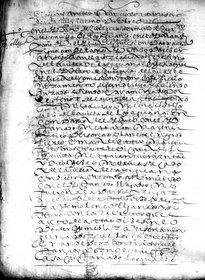
The new Spanish Paleography Tool developed by the CUNY DSI at City College will make it possible to decipher and read handwriting styles like this used in the Spanish-speaking world in the colonial era.
The CUNY Dominican Studies Institute at The City College of New York has rolled out the first prototype of a unique online tool to decode the various Spanish-language writing styles common in the 16th and 17th centuries.
The "Spanish Paleography Digital Teaching and Learning Tool" will make it possible to teach anyone to decipher and read the handwriting styles used in the Spanish-speaking world in the colonial era.
"By bringing together a number of digital interactive functions, the tool constitutes a much more effective pedagogical resource than any of the others devoted to Spanish manuscripts so far," said Dr. Ramona Hernández, director of CUNY DSI and project executive director.
Until now, only a tiny number of specialized scholars with PhDs had the ability to read the three or four distinct scripts prevalent in societies of Spanish culture. CUNY DSI wanted to enable a larger population to be able to read the documents and obtained a grant for the project from the National Endowment for the Humanities (NEH) Office of Digital Humanities.
"We think the project will greatly impact an important area of the study of the humanities and studies about the written culture generated in the Spanish-language world during the modern period," added Dr. Hernández, a professor of sociology in the Colin L. Powell School for Civic and Global Leadership at City College.
In addition to enhancing the study of old manuscripts, the tool is also being hailed as a potential job training resource. Because it will be an open source and available to the public, the site could expand the teaching of paleographic skills to historians and students.
She added that making the technology widely available could expand the number of researchers engaged in scholarship of Spanish colonial societies and cultures. "Creating this new base of researchers trained in the reading of primary sources might revolutionize the field in ways that we never thought of before, and that is why we see the Spanish Paleography Tool as an instrument to democratize knowledge."
About The City College of New York
Since 1847, The City College of New York has provided low-cost, high-quality education for New Yorkers in a wide variety of disciplines. More than 16,000 students pursue undergraduate and graduate degrees in: the College of Liberal Arts and Sciences; the Bernard and Anne Spitzer School of Architecture; the School of Education; the Grove School of Engineering; the Sophie Davis School of Biomedical Education, and the Colin L. Powell School for Civic and Global Leadership. U.S. News, Princeton Review and Forbes all rank City College among the best colleges and universities in the United States. For additional information, visitwww.ccny.cuny.edu.